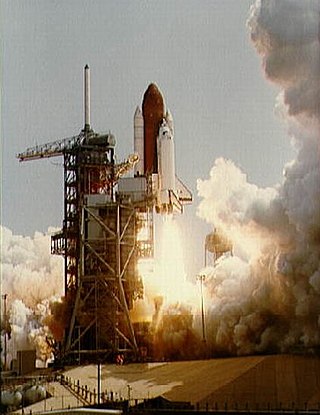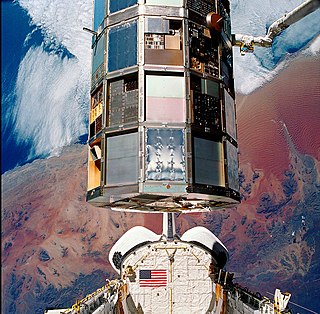
The Space Shuttle is a retired, partially reusable low Earth orbital spacecraft system operated from 1981 to 2011 by the U.S. National Aeronautics and Space Administration (NASA) as part of the Space Shuttle program. Its official program name was Space Transportation System (STS), taken from a 1969 plan for a system of reusable spacecraft where it was the only item funded for development.

Space Shuttle Challenger (OV-099) was a Space Shuttle orbiter manufactured by Rockwell International and operated by NASA. Named after the commanding ship of a nineteenth-century scientific expedition that traveled the world, Challenger was the second Space Shuttle orbiter to fly into space after Columbia, and launched on its maiden flight in April 1983. It was destroyed in January 1986 soon after launch in a disaster that killed all seven crewmembers aboard.

Space Shuttle Discovery is a retired American spacecraft. The spaceplane was one of the orbiters from NASA's Space Shuttle program and the third of five fully operational orbiters to be built. Its first mission, STS-41-D, flew from August 30 to September 5, 1984. Over 27 years of service it launched and landed 39 times, aggregating more spaceflights than any other spacecraft to date. The Space Shuttle launch vehicle had three main components: the Space Shuttle orbiter, a single-use central fuel tank, and two reusable solid rocket boosters. Nearly 25,000 heat-resistant tiles cover the orbiter to protect it from high temperatures on re-entry.

STS-9 was the ninth NASA Space Shuttle mission and the sixth mission of the Space Shuttle Columbia. Launched on 28 November 1983, the ten-day mission carried the first Spacelab laboratory module into orbit.

STS-4 was the fourth NASA Space Shuttle mission, and also the fourth for Space Shuttle Columbia. Crewed by Ken Mattingly and Henry Hartsfield, the mission launched on June 27, 1982, and landed a week later on July 4, 1982. Due to parachute malfunctions, the SRBs were not recovered.

STS-6 was the sixth NASA Space Shuttle mission and the maiden flight of the Space ShuttleChallenger. Launched from Kennedy Space Center on April 4, 1983, the mission deployed the first Tracking and Data Relay Satellite, TDRS-1, into orbit, before landing at Edwards Air Force Base on April 9, 1983. STS-6 was the first Space Shuttle mission during which a Extravehicular activity was conducted, and hence was the first in which the Extravehicular Mobility Unit (EMU) was used.

On January 28, 1986, the Space Shuttle Challenger broke apart 73 seconds into its flight, killing all seven crew members aboard. The spacecraft disintegrated 46,000 feet (14 km) above the Atlantic Ocean, off the coast of Cape Canaveral, Florida, at 11:39 a.m. EST. It was the first fatal accident involving an American spacecraft while in flight.

STS-32 was the 33rd mission of NASA's Space Shuttle program, and the ninth launch of Space ShuttleColumbia. Launched on January 9, 1990, it marked the first use of the Launch Complex 39A of Kennedy Space Center since 1986; it also marked the first use of Mobile Launcher Platform-3 (MLP-3) in the Space Shuttle program. STS-32 was, at the time, the longest shuttle mission yet conducted, with a duration of nearly 11 days. Before STS-32, the only mission of the same duration had been STS-9 in 1983. On January 20, 1990, STS-32 executed the third night landing of the shuttle program. STS-32 was also the first Shuttle mission of the 1990s.

STS-41-D was the 12th flight of NASA's Space Shuttle program, and the first mission of Space Shuttle Discovery. It was launched from Kennedy Space Center, Florida, on August 30, 1984, and landed at Edwards Air Force Base, California, on September 5, 1984. Three commercial communications satellites were deployed into orbit during the six-day mission, and a number of scientific experiments were conducted, including a prototype extendable solar array that would eventually form the basis of the main solar arrays on the International Space Station (ISS).

STS-51-D was the 16th flight of NASA's Space Shuttle program, and the fourth flight of Space Shuttle Discovery. The launch of STS-51-D from Kennedy Space Center (KSC), Florida, on April 12, 1985, was delayed by 55 minutes, after a boat strayed into the restricted Solid Rocket Booster (SRB) recovery zone. STS-51-D was the third shuttle mission to be extended.

STS-51-B was the 17th flight of the NASA Space Shuttle program and the seventh flight of Space Shuttle Challenger. The launch of Challenger on April 29, 1985, was delayed by 2 minutes and 18 seconds, due to a launch processing failure. Challenger was initially rolled out to the pad to launch on the STS-51-E mission. The shuttle was rolled back when a timing issue emerged with the TDRS-B satellite. When STS-51-E was canceled, Challenger was remanifested with the STS-51-B payloads. The shuttle landed successfully on May 6, 1985, after a week-long mission.

STS-51-G was the 18th flight of NASA's Space Shuttle program, and the fifth flight of Space Shuttle Discovery. The seven-day mission launched from Kennedy Space Center, Florida, on June 17, 1985, and landed at Edwards Air Force Base, California, on June 24, 1985. Sultan bin Salman Al Saud from Saudi Arabia was on board as a payload specialist; Al Saud became the first Arab, the first Muslim, and the first member of a royal family to fly into space. It was also the first Space Shuttle mission which flew without at least one astronaut from the pre-Shuttle era among its crew.

STS-61-A was the 22nd mission of NASA's Space Shuttle program. It was a scientific Spacelab mission, funded and directed by West Germany – hence the non-NASA designation of D-1. STS-61-A was the ninth and last successful flight of Space Shuttle Challenger before the disaster. STS-61-A holds the current record for the largest crew—eight people—aboard any single spacecraft for the entire period from launch to landing.

STS-61-C was the 24th mission of NASA's Space Shuttle program, and the seventh mission of Space Shuttle Columbia. It was the first time that Columbia, the first space-rated Space Shuttle orbiter to be constructed, had flown since STS-9. The mission launched from Florida's Kennedy Space Center on January 12, 1986, and landed six days later on January 18, 1986. STS-61-C's seven-person crew included the first Costa Rican-born astronaut, Franklin Chang-Díaz, and 2 future Administrators of NASA: the second African-American shuttle pilot, Charles Bolden, and the second sitting politician to fly in space, Representative Bill Nelson (D-FL). It was the last shuttle mission before the Space Shuttle Challenger disaster, which occurred ten days after STS-61-C's landing.

STS-30 was the 29th NASA Space Shuttle mission and the fourth mission for Space Shuttle Atlantis. It was the fourth shuttle launch since the Challenger disaster and the first shuttle mission since the disaster to have a female astronaut on board. The mission launched from Kennedy Space Center, Florida, on May 4, 1989, and landed four days later on May 8, 1989. During the mission, Atlantis deployed the Venus-bound Magellan probe into orbit.

STS-28 was the 30th NASA Space Shuttle mission, the fourth shuttle mission dedicated to United States Department of Defense (DoD) purposes, and the eighth flight of Space Shuttle Columbia. The mission launched on August 8, 1989, and traveled 3,400,000 km (2,100,000 mi) during 81 orbits of the Earth, before landing on runway 17 of Edwards Air Force Base, California, on August 13, 1989. STS-28 was also Columbia's first flight since January 1986, when it had flown STS-61-C, the mission directly preceding the Challenger disaster of STS-51-L. The mission details of STS-28 are classified, but the payload is widely believed to have been the first SDS-2 relay communications satellite. The altitude of the mission was between 295 km (183 mi) and 307 km (191 mi).

STS-33 was a NASA Space Shuttle mission, during which Space Shuttle Discovery deployed a payload for the United States Department of Defense (DoD). It was the 32nd shuttle mission overall, the ninth flight of Discovery, the fifth shuttle mission in support of the DoD, the seventh post-Space Shuttle Challenger disaster mission and the last Shuttle mission of the 1980s. Due to the nature of the mission, specific details remain classified. Discovery lifted off from Launch Complex 39B at Kennedy Space Center (KSC), Florida, on November 22, 1989, at 7:23:30 p.m. EST; it landed at Edwards Air Force Base, California, on November 27, 1989, at 7:30:16 p.m. EST.

STS-38 was a Space Shuttle mission by NASA using the Space Shuttle Atlantis. It was the 37th shuttle mission, and carried a classified payload for the U.S. Department of Defense (DoD). It was the seventh flight for Atlantis and the seventh flight dedicated to the Department of Defense. The mission was a 4-day mission that traveled 3,291,199 km (2,045,056 mi) and completed 79 revolutions. Atlantis landed at Kennedy Space Center's Shuttle Landing Facility's runway 33. The launch was originally scheduled for July 1990, but was rescheduled due to a hydrogen leak found on Space ShuttleColumbia during the STS-35 countdown. During a rollback to the Orbiter Processing Facility Atlantis was damaged during a hail storm. The eventual launch date of November 15, 1990, was set due to a payload problem. The launch window was between 18:30 and 22:30 EST. The launch occurred at 18:48:13 EST.

STS-51-L was the disastrous 25th mission of NASA's Space Shuttle program and the final flight of Space Shuttle Challenger.
The Manned Spaceflight Engineer Program was an effort by the United States Air Force to train American military personnel as payload specialists for United States Department of Defense missions on the Space Shuttle program.
























